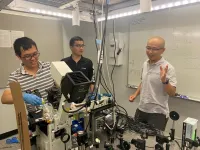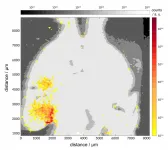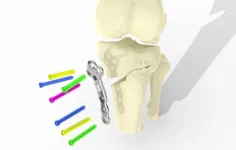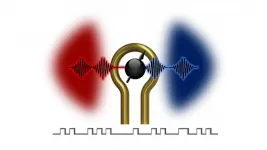(Press-News.org) RESEARCH TRIANGLE PARK, N.C. -- Army-funded research identified a new chemistry approach that could remove micropollutants from the environment.
Micropollutants are biological or chemical contaminants that make their way into ground and surface waters in trace quantities.
Using a pioneering imaging technique, Cornell University researchers obtained a high-resolution snapshot of how ligands, molecules that bind to other molecules or metals, interact with the surface of nanoparticles. In doing so, they made an unexpected breakthrough discovery. They determined that by varying the concentration of an individual ligand they could control the shape of the particle it attached too.
This approach could result in an array of daily applications, including developing chemical sensors that are sensitive at a very low level to a specific chemical in the environment.
"Professor Peng Chen's work allows for deep insights into molecular adsorption processes, which is important to understand for designing molecular sensors, catalysts, and schemes to clean up micro-pollutants in the environment," said Dr. James Parker, program manager, U.S. Army Combat Capabilities Development Command, known as DEVCOM, Army Research Laboratory. "This research is also important for designing and engineering stimuli-responsive materials with specialized function that could not be found in regular, bulk materials."
The research, published in Nature Communications, studied interactions of ligands and gained new understanding of the strength, or affinity of ligand adsorption as well as how multiple ligands cooperate, or don't, with each other.
"When the molecule adsorbs on the surface of a nanoscale material, it also actually protects the surface and makes it more stable," said Dr. Peng Chen, the Peter J.W. Debye Professor of Chemistry in the College of Arts and Sciences at Cornell University, who led the research. "This can be utilized to control how nanoscale particles grow and become their eventual shape. And we found we can do this with just one ligand. You don't do any other trick. You just decrease the concentration or increase the concentration, and you can change the shape."
Understanding how ligands interact with the surface of nanoparticles has been a challenge to study. Adsorbed ligands are difficult to identify because there are other molecules in the mix, and nanoparticle surfaces are uneven and multifaceted, which means they require incredibly high spatial resolution to be scrutinized.
A nanoparticle's size and surface structures, or facets, are intrinsically tied to the particle's potential applications. The larger the particle, the more atoms fit inside it, while smaller particles have less available space internally but a greater surface volume ratio for atoms to sit atop, where they can be utilized for processes such as catalysis and adsorption. The different types of structures the atoms and molecules form on these surface facets are directly correlated with the particle's shape.
Army-funded research identifies a new chemistry approach that could remove micropollutants from the environment.
Scientists have used several imaging methods to survey these particles, but until now, they haven't been able to obtain nanometer resolution to really explore the nooks and crannies of the multiple surface facets and quantify the affinity, or strength, of a ligand's adsorption. The research team was able to do just that by employing a method of their own devising called COMPetition Enabled Imaging Technique with Super-Resolution or COMPEITS.
The process works by introducing a molecule that reacts with the particle surface and generates a fluorescent reaction. A nonfluorescent molecule is then sent to bind to the surface, where its reaction competes with the fluorescent signal. The resulting decrease in fluorescence, essentially creating a negative image, can then be measured and mapped with super high resolution.
Using COMPEITS on a gold nanoparticle, the team was able to quantify the strength of ligand adsorption, and they discovered ligand behavior can be very diverse. Ligands, it turns out, are fair-weather friends of a sort, at some sites they cooperate to help each other adsorb, but at other sites they can impair each other's efforts. The researchers also discovered that sometimes this positive and negative cooperativity exists at the same site.
In addition, the researchers learned that the surface density of adsorbed ligands can determine which facet is dominant. This crossover inspired the team to vary the concentrations of individual ligands as a way to tune the shape of the particle itself.
"For us, this has opened more possibilities," Chen said. "For example, one way to remove micropollutants, such as pesticides, from the environment is to adsorb micro-portions on the surface of some adsorbent particle. After it is adsorbed on the surface of the particle, if the particle is a catalyst, it can catalyze the destruction of the micropollutants."
INFORMATION:
In addition to ARL, the Center for Alkaline-Based Energy Solutions, an Energy Frontier Research Center of U.S. Department of Energy supported the research.
Visit the laboratory's Media Center to discover more Army science and technology stories
As the Army's national research laboratory, ARL is operationalizing science to achieve transformational overmatch. Through collaboration across the command's core technical competencies, DEVCOM leads in the discovery, development and delivery of the technology-based capabilities required to make Soldiers more successful at winning the nation's wars and come home safely. DEVCOM Army Research Laboratory is an element of the U.S. Army Combat Capabilities Development Command. DEVCOM is a major subordinate command of the Army Futures Command.
When there is a gas leak in a large building or at an industrial site, human firefighters currently need to go in with gas sensing instruments. Finding the gas leak may take considerable time, while they are risking their lives. Researchers from TU Delft (the Netherlands), University of Barcelona, and Harvard University have now developed the first swarm of tiny - and hence very safe - drones that can autonomously detect and localize gas sources in cluttered indoor environments.
The main challenge the researchers needed to solve was to design the Artificial Intelligence for this complex task that would fit in the tight computational and memory constraints of the tiny drones. They solved this challenge by means of bio-inspired navigation and search strategies. The scientific ...
A new study finds forensics researchers use terms related to ancestry and race in inconsistent ways, and calls for the discipline to adopt a new approach to better account for both the fluidity of populations and how historical events have shaped our skeletal characteristics.
"Forensic anthropology is a science, and we need to use terms consistently," says Ann Ross, corresponding author of the study and a professor of biological sciences at North Carolina State University. "Our study both highlights our discipline's challenges in discussing issues ...
Super-thin carbon molecular sieve (CMS) membranes may not be best for separating industrially important chemical mixtures. However, ensuring the CMS film thickness is just right could enable more energy-efficient purification of chemical products, KAUST researchers have shown.
CMS membranes, as their name suggests, can purify mixtures of liquids or gases by permitting only certain molecules to pass through their subnanometer-sized pores. Currently, the chemical industry mainly uses heat-based processes such as distillation to separate product mixtures, but these processes consume about 10 percent of global energy output. "This situation is highly unsustainable," says Wojciech Ogieglo, a research scientist at KAUST. "We believe that a good ...
The premise of heated tobacco (HT) is simple: tobacco leaf is heated, never burnt, so avoiding many harmful by-products of combustion for the user. The exhaled 'mist' is correctly termed an aerosol, which is almost invisible and far less dense and pungent than the exhaled smoke from combustible cigarettes.
Another advantage of HT is that there are no 'side-stream' emissions to impact air quality (or disturb bystanders - these emissions form part of the ambient smoke that's often known as environmental tobacco smoke (ETS) or 'second-hand' smoke), because unlike a combustible cigarette there is no constantly burning tip. Our previous research suggests that, unlike cigarettes, using our Pulze heated tobacco device causes no negative impact on indoor air quality ...
Researchers have found evidence for an anomalous phase of matter that was predicted to exist in the 1960s. Harnessing its properties could pave the way to new technologies able to share information without energy losses. These results are reported in the journal Science Advances.
While investigating a quantum material, the researchers from the University of Cambridge who led the study observed the presence of unexpectedly fast waves of energy rippling through the material when they exposed it to short and intense laser pulses. They were able to make these observations by using a microscopic speed camera that can track small and very fast movement on a scale that is challenging with many other techniques. This technique probes the material with two light pulses: the first one disturbs it ...
In lab tests, Imperial researchers have created a metal-based molecule that inhibits the build-up of a peptide associated with Alzheimer's disease.
A peptide is a fragment of a protein, and one of the key hallmarks of Alzheimer's disease is the build-up of a specific peptide known as amyloid-β. The team demonstrated that with the aid of ultrasound, their molecule can cross the blood-brain barrier in mice, targeting the part of the brain where the damaging peptide most often accumulates.
Alzheimer's disease is the most common form of dementia, affecting approximately 50 million people worldwide. There is a pressing need to develop drugs ...
Pioneering 'printed metal' procedure to create bespoke treatment for early knee osteoarthritis set to be trialled in the UK following MHRA approval.
World's first 3D printed high tibial osteotomy (HTO) device and procedure developed at University of Bath given approval for UK trials
Bespoke titanium alloy HTO implants that fit perfectly are designed to reduce discomfort for knee osteoarthritis patients
Sophisticated 3D scanning aims to make surgery quicker and safer
New TOKA process could make earlier intervention possible - saving patients decades of pain before surgery becomes viable
Intro
A ...
Many of us swing through gates every day -- points of entry and exit to a space like a garden, park or subway. Electronics have gates too. These control the flow of information from one place to another by means of an electrical signal. Unlike a garden gate, these gates require control of their opening and closing many times faster than the blink of an eye.
Scientists at the U.S. Department of Energy's (DOE) Argonne National Laboratory and the University of Chicago's Pritzker School of Molecular Engineering have devised a unique means of achieving effective gate operation with a form of information processing called electromagnonics. Their pivotal discovery allows real-time control of information transfer between microwave photons and magnons. And it could result in a new generation ...
An important new study by researchers at the U.S. Department of Energy's (DOE) Argonne National Laboratory has yielded critical fresh insights into the lithium production process and how it relates to long-term environmental sustainability, particularly in the area of transportation with batteries and electric vehicles.
The paper, "Energy, Greenhouse Gas, and Water Life Cycle Analysis of Lithium Carbonate and Lithium Hydroxide Monohydrate from Brine and Ore Resources and Their Use in Lithium Ion Battery Cathodes and Lithium Ion Batteries," in the journal ...
Prof. PAN Jianwei and Prof. ZHANG Jun from University of Science of Technology of China (USTC) of the Chinese Academy of Sciences, collaborating with Prof. CHU Tao's group from Zhejiang University, realized the fastest and miniaturized real-time quantum random number generator (QRNG) with the record-breaking output rate of 18.8 Gbps by combing a state-of-the-art photonic integrated chip with the optimized real-time post processing. The study was published in Applied Physics Letters on June 29.
Random number exists in many fields such as information security and cryptology industries. Different from other random number generators, QRNG, as the key part in quantum communication system, embraces the characteristics ...







